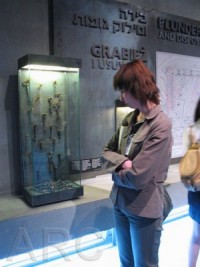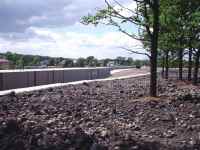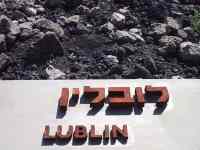 |
| In the Museum |
Visiting Hours:
Memorial Site
9 a.m. – 6 p.m. daily, including weekends (from 1 April until 31 October)
8 a.m. – 4 p.m. daily, including weekends (from 2 November until 31 March)
Exhibition and Museum
9 a.m. – 5 p.m. daily, including weekends (from 2 April until 31 October)
9 a.m. – 4 p.m. daily, including weekends (from 2 November until 31 March)
The admission to all parts of the Belzec Memorial
(
180° Panorama)) is free.
For guided tours please ask at the reception (museum entrance).
Taking photos and films of the Belzec Memorial is allowed only by written permission of the Head of Belzec Museum
or the Director of Majdanek State Museum in Lublin.
You can send your requiries to
belzec.memorial@op.pl
A Description of the Concept of the Cemetery
Memorial to the Victims of the Nazi Death Camp in Belzec.
Belzec 1942 - the place and time of a great tragedy of Jewish people, one of the greatest Crimes in the
history of humanity - stood waiting for a fitting memorial for more than half a century.
 |
| The Museum in 2004 |
Our main task was to find the form of the Cemetery for this place that would appropriately honour and
venerate the Jews murdered here according to tradition, culture and religion in which they and their
ancestors lived. Our architectural - sculptural concept covers the entire area of the former death camp.
The most important element of the composition is the space of the symbolic mass grave containing authentic
mass gravesites within its borders.
 |
| The Interstice |
At the historical point of the rail siding we placed the main entrance to the Cemetery. Its elements include
the Ramp and Museum building. The complex of these elements on the side of the city comprises
a form of the cemetery wall. The only exit from the Ramp is the Way, which slopes gently into
unassuming, even nondescript terrain, leading us into the perfectly straight Interstice - like a crack
in the earth - forming the Interstice - Way with no return. A square is created at the point of
crossing into the circumference of the Cemetery - Burial Ground.
 |
| The Stone Wall |
The cut and open earth uncovers the hidden elevation of the terrain, and reveals the dimensions of the crime.
Through the towering height of the walls blotting out the sky, it evokes the terror of one of the greatest
graves in the world. The culminating point of the passage is the granite Stone Wall. Its relief is a
record of traces of individual tragedy of the victims. This is a place of pause and reflection.
Turning around, we face the Niche with engraved inscriptions of the victims.
 |
| The Cast-Iron Border |
From the underground, stairs lead off to the left and right allowing people to go outside. The way out is
marked by the pedestrian walk along the Cast-iron Border. Its surface is covered with inscriptions
bearing the names of communities of the murder victims and dates creating a calendar of the crime. This is
also a place for laying memorial stones and candles.
Those trees that were witness to the events will be kept on the terrain marked out by the great
Burial Ground. The surface of the gravesite will be covered with a layer of special sterile soil, half
a metre thick, while maintaining the original contours of the land. This will demonstrate the exceptional
nature of this place and the enduring memory of the tragedy.
Andrzej Solyga, Zdzislaw Pidek, Marcin Roszczyk
Sculptors
Memorial Photos
Official 2005 Leaflet (English or Polish), available only at the museum
entrance or from ARC. This leaflet includes the newest camp maps, useful for understanding the former camp's
structures.
© ARC (http://www.deathcamps.org) 2005














